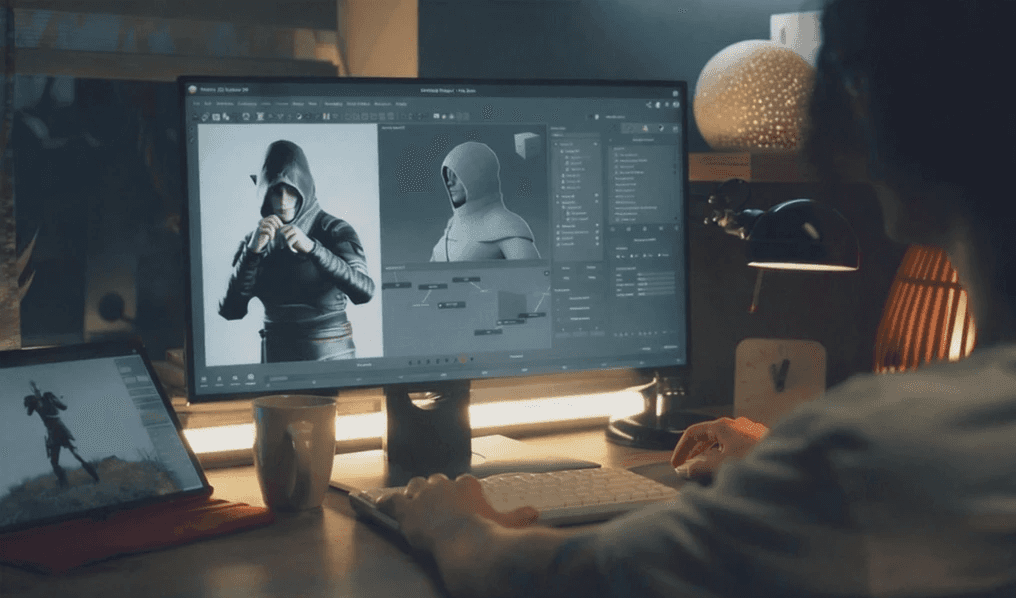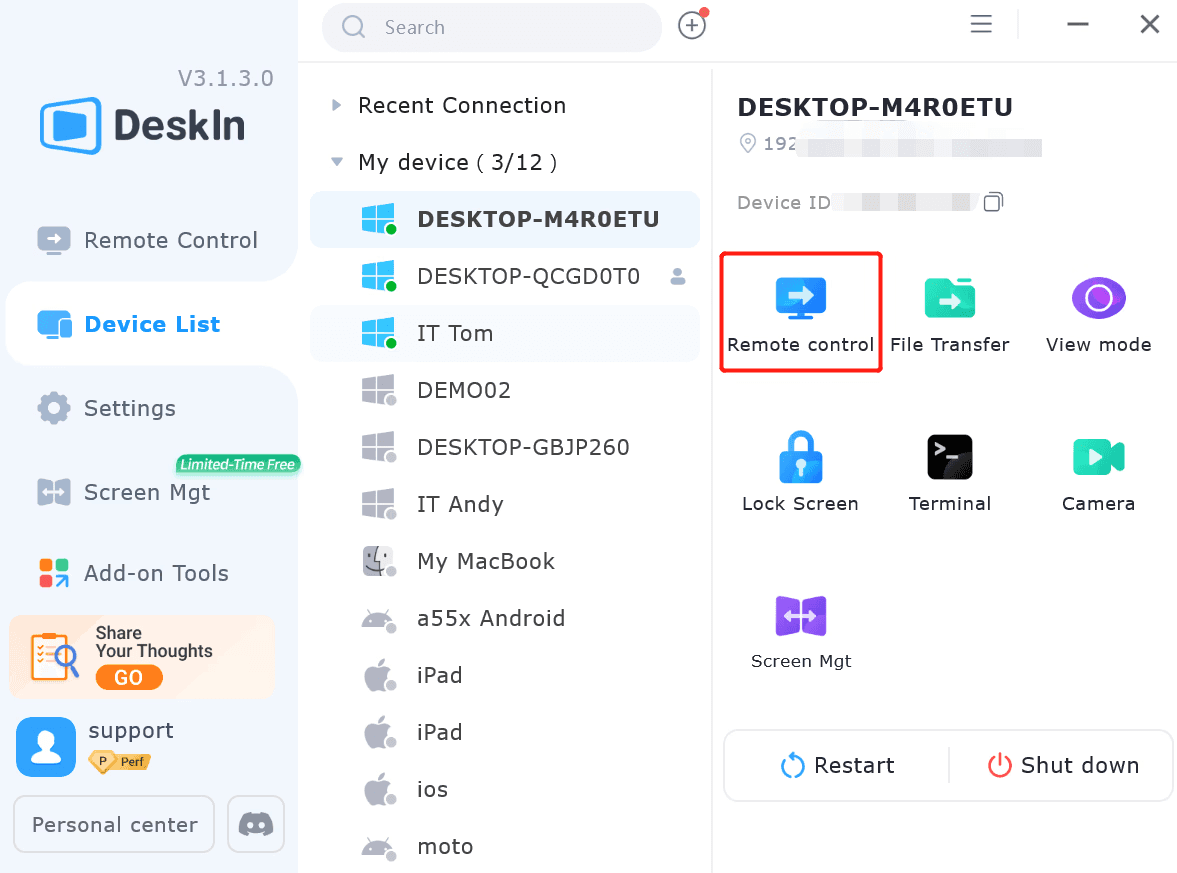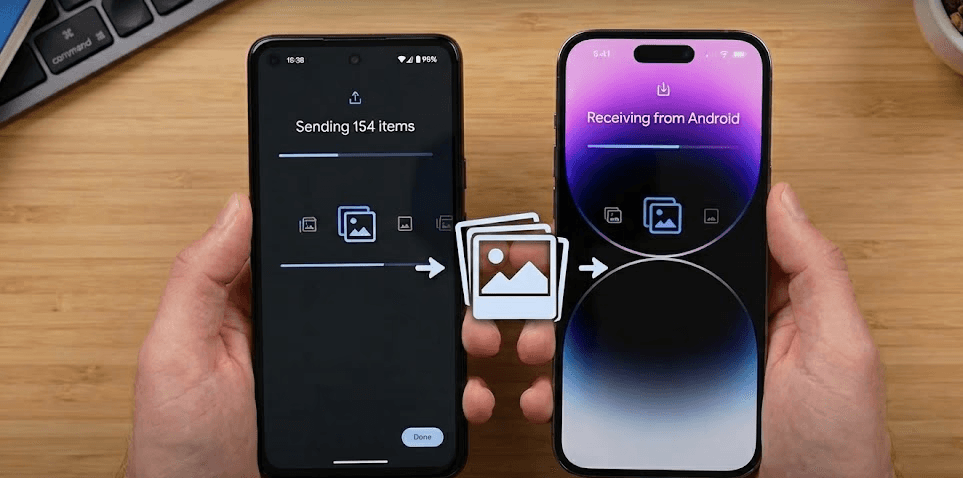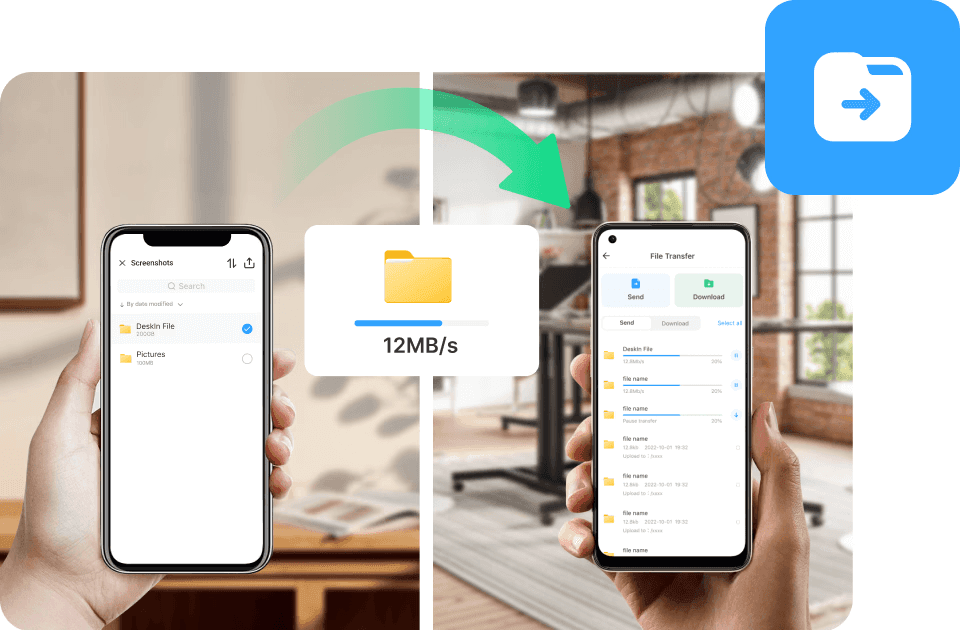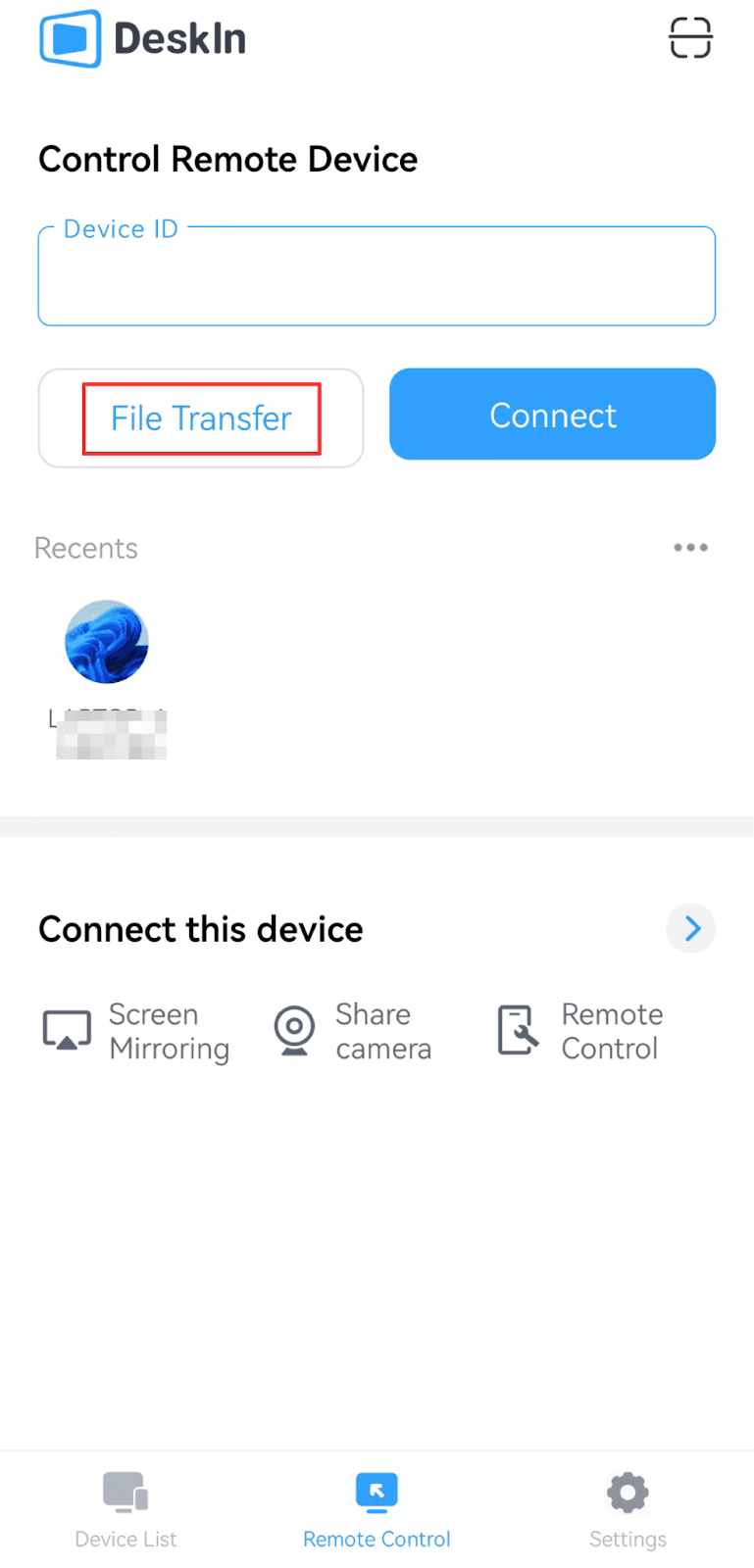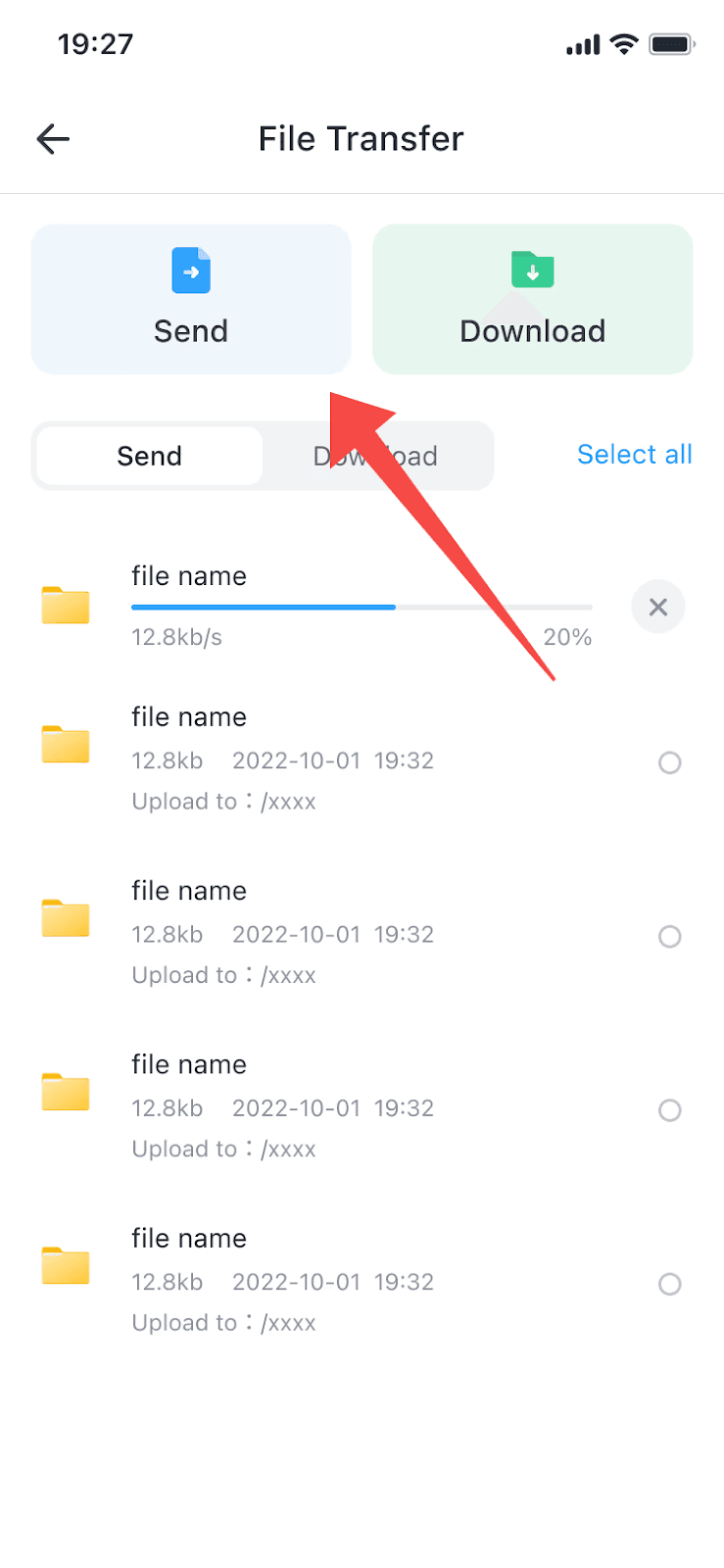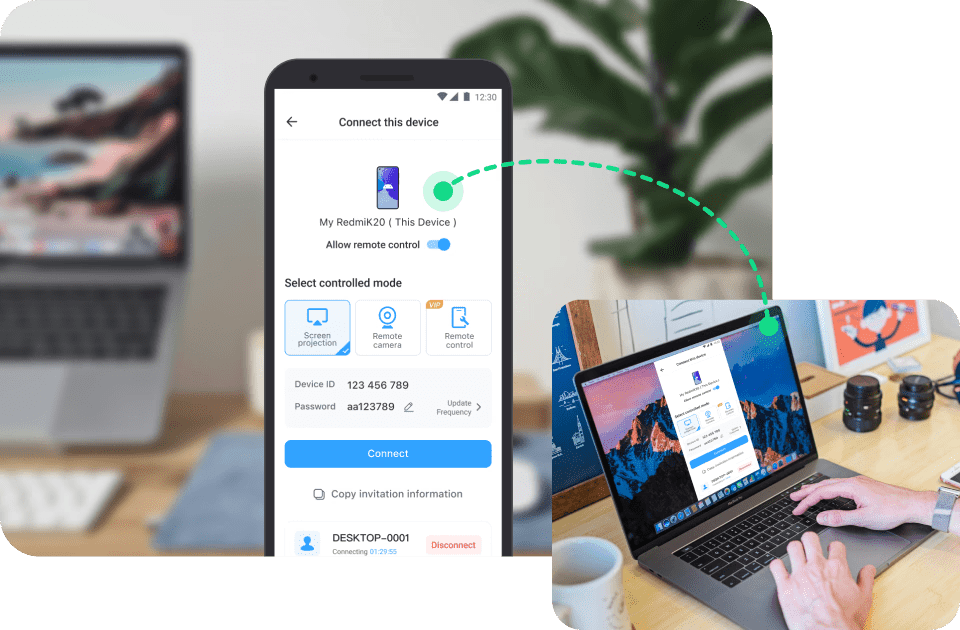In an increasingly remote and mobile-first world, more people are able to access files while they are on the move, stay connected with their workstations, or assist family members by turning to remote desktop tools. You might be working as a freelancer or an IT technician. Remote control and remote viewing are greatly affected by the correct tool if home computer access is desired.
TeamViewer is the name that often comes to mind for people thinking of remote access. This well-established platform offers strong features. However, depending on your particular needs — for instance, easy usage, mobile performance, or quick connection — you may question if there’s a TeamViewer alternative that fits your workflow better.
DeskIn Remote Desktop could be worth a closer look if you are seeking simplicity along with smoothness. The software is also for modern users.
If you’re exploring options beyond TeamViewer, you might also like our top picks for remote desktop software in 2025.
Why People Search for “TeamViewer Alternative”
While TeamViewer is indeed a trusted name, user expectations for remote access have evolved now. As the cost-efficiency, mobile functionality, and flexibility needs grow, many people explore tools that are better aligned for their daily use.
1. Inconsistent Connection Experience
For many users, a smooth as well as stable connection is important, especially when they work remotely, assist others, or access time-sensitive files. However, there are occasional reports of lag at times. Unclear picture quality or slow response occurs with weaker network connections.
Plus, the free versions can cause some users to encounter interruptions or restrictions, especially in the event that TeamViewer’s system falsely flags their sessions as commercial activity. For those who rely on consistent remote desktop performance, this can lead to unnecessary disruptions.
2. Pricing May Not Match Individual Needs
Most platforms, including TeamViewer, offer both free and premium plans. However, the cost can become a consideration for users with more advanced requirements like file transfers, cross-platform use, or extended session time.
For annual subscriptions in particular, there may be features included such as user management and advanced access policies designed for enterprise IT teams, features that may not be necessary for more freelance use or personal use. For individual users, it can be difficult for them to find a plan that matches their budgets along with their actual needs.
3. Limited Flexibility for Diverse Use Cases
Many traditional remote access software tools, including TeamViewer, were in fact designed originally for remote work that is office-based. However, users' needs are now changing. Modern users are becoming more diverse now.
Users are now looking for tools that adapt to daily situations such as remote gaming, creative collaboration, and mobile device access, not just for IT support. Some platforms may still focus primarily on desktop-to-desktop connections and offer limited functionality or control when accessed from smartphones or tablets.
4. Heavy Resource Consumption
While TeamViewer offers a strong feature set, system resources can experience a noticeable load under use. Especially if computers are older or have limited processing power, users may experience fan noise, screen delays, or slower performance during active sessions. Plus, when the internet connections are slower may produce lag along with reduced responsiveness, when intensive tasks like real-time screen sharing or file transfers are performed.
What "Simple" Means for Remote Access

When users search for a TeamViewer alternative, “simple” is just a word that often comes up. But the simple remote desktop software doesn’t mean it offers fewer features — it means features are easy to use, even for someone who’s not especially tech-savvy.
In today’s fast-moving, remote-first world, remote access tools need to be powerful enough for work but simple enough for everyday use. Let’s take a closer look at what that really involves:
1. Minimal Setup for Both Sides
One of the biggest barriers to using remote access software is the setup process, especially when you’re trying to help someone who isn’t tech-oriented. A simple remote access tool should require little to no configuration:
No port forwarding or firewall adjustments
No need to create an account just to get started
No complicated device pairing or setup wizards
Ideally, connecting should be as easy as sending a secure link or entering a quick session code. The fewer the steps, the faster the support.
2. Clear and Intuitive Interface
A “simple” remote desktop experience should feel natural, with a user interface that clearly guides you, rather than making you guess which button to click.
Look for tools that offer:
A clean dashboard with labeled actions
Easy-to-find controls like “Connect,” “Share Screen,” or “Transfer Files”
Touch-friendly layouts for mobile users
Simplicity in design reduces user error and builds confidence, especially when time is of the essence.
3. Fast, Reliable Connections
A great remote viewing experience depends on how quickly and reliably two devices can connect. Simple software should:
Establish connections in under 10 seconds
Maintain smooth screen updates even on slower connections
Automatically adjust resolution or bandwidth for optimal performance
This is particularly important for remote workers, freelancers, or users on mobile data, where stable connections aren’t always guaranteed.
4. Essential Features That “Just Work”
You don’t need dozens of advanced IT functions if all you’re trying to do is check a file or help a friend with an app issue. A simple remote desktop should make the core features work effortlessly:
Remote control with mouse and keyboard input
Screen sharing in real-time
File transfer between devices
Session permission controls for security
It’s not about how many features there are — it’s about how easily you can use the ones that matter most.
5. Cross-Platform Compatibility
Modern users are not limited to only one device anymore. The remote desktop software should adapt to any device, whether it is a Windows PC, a MacBook, or a smartphone.
“Simple” access means:
Windows to macOS, or Android to PC — no problem
Support for iOS/iPadOS with full control, not just viewing
Consistent performance across platforms
The more flexible the platform, the more use cases it can support — whether you’re working, helping someone, or grabbing a file in a pinch.
6. Security Without Complexity
Remote access should always be secure, but security shouldn’t come at the cost of usability. Simple remote access tools balance protection with ease of use:
Encrypted sessions by default
Permission-based access requests
Automatic session timeouts or logs for accountability
A well-designed remote desktop solution keeps your data safe while letting you stay focused on your work, not on navigating complex settings or security policies.
Why DeskIn Remote Desktop is the Best Alternative to TeamViewer?

If you're looking to find a remote desktop solution that can be user-friendly and is also responsive and packed with those features that do actually matter, DeskIn is worth your consideration. Here’s a breakdown of what makes it a standout TeamViewer alternative for individuals, freelancers, and remote teams alike:
👉 click here to download DeskIn
Commercial Use Allowed
DeskIn’s free plan is more flexible than most since it lets you use it for personal or commercial purposes without limitations. It allows for a maximum of three remote devices. Connecting has no time restrictions. Whether you help a client, manage multiple PCs, or provide support for family, you’ll have uninterrupted sessions even within the free tier — a rare offering in the world of remote access software.
High Image Quality with Low Latency
DeskIn is optimized for visual clarity and responsiveness. The free version supports 1080p, while paid plans unlock up to 4K and 60fps or 2K and 144fps — perfect for design work, presentations, or even gaming. Latency averages below 40ms. You also have full control to manually adjust resolution, frame rate, and quality settings. Advanced rendering features like hard coding and D3D ensure a smooth, tear-free experience — a clear strength when compared with any TeamViewer alternative.
If you’ve used the Windows app remote desktop before, you’ll notice that DeskIn gives you far more control over resolution and performance, especially for creative or visual work.
Easy-to-Use Interface for All Experience Levels
Simplicity is one of DeskIn’s biggest strengths. The main dashboard is both clean and also well-organized. First-time users can also navigate it easily. On mobile, there are intuitive controls such as a virtual mouse and pre-set shortcut keys that make it feel like you are working directly on the device. Tasks like copy/paste, window switching, or opening the task manager can be done in a tap — features many expect from a modern remote desktop solution.
Fast Connections and High-Speed File Transfers

Time matters and DeskIn minimizes waiting with quick connection times — typically just a few seconds. It also supports file transfer speeds up to 12MB/s across all plans, including the free version. Whether you’re retrieving files from your remote PC or sharing resources with a colleague, transfers are smooth and efficient.
Versatile Features for Work, Gaming, and Collaboration
DeskIn offers a broad range of features to support different use cases. You can make audio calls, use a remote camera, or annotate on a whiteboard during support sessions. For gamers, DeskIn supports gaming mice, keyboards, gamepads, and even 3D view mode. Its advanced screen management functions — including screen mirroring, projection, and virtual displays — also make it ideal for multitasking or extended workspace setups, far beyond what a typical TeamViewer alternative may offer.
Strong Security with User-Centered Controls
Security is built into every aspect of DeskIn. All sessions get encrypted via 256-bit tech so your data stays protected. Features such as email verification for new devices, session privacy screens, and black/white list management help prevent forbidden access. For mobile users, sensitive actions like password entry are automatically masked by a black screen to prevent phishing or data leaks during remote desktop sessions.
Affordable Plans That Fit Your Needs

DeskIn offers flexible pricing without locking you into long-term contracts. The free version is powerful enough for casual users, while the paid plans are structured around real-world usage, from freelancers to tech support professionals. Best of all, subscriptions are available monthly, and the pricing is more accessible compared to enterprise-oriented platforms like TeamViewer. For individuals and small teams looking for a TeamViewer alternative, DeskIn provides excellent value. Go check DeskIn Plans.
DeskIn vs TeamViewer: Feature-by-Feature Comparison
Feature | DeskIn | TeamViewer |
Free Version Usage | Free version supports commercial use, allows up to 3 devices, no time or speed restrictions. | Free version is limited to personal use only up to 3 devices; commercial use requires an upgrade. |
Mobile Control | Full remote control from iOS and Android with shortcut keys and virtual mouse. | Mobile apps are available, but often limited to reduced functionality. |
Latency & Performance | Low-latency (<40ms) with smooth control, even on weaker networks. | Performance varies; responsive on stable networks, but may lag under load. |
Streaming Quality | Supports 1080p (free), up to 4K60fps or 2K144fps (paid), with manual quality controls. | High resolution is supported, but quality is auto-adjusted with fewer control options. |
File Transfer Speed | Up to 12MB/s, even in the free version, with no speed limits. | File transfer is available, but speed may be limited by the plan or network. |
Gaming Support | Supports gaming keyboards, mice, 3D view, and game controllers. | Not intended or optimized for remote gaming scenarios. |
Interface Design | Clean, intuitive UI designed for beginners and mobile workflows. | Feature-rich, but may feel complex or technical for casual users. |
Pricing & Plans | Free plan is work-friendly; paid plans are affordable and available monthly. | Business plans are annual only, with pricing tailored to enterprise use. |
Real-Life Use Cases: When DeskIn Wins
Let’s explore a few everyday scenarios where DeskIn can offer a seamless experience:
Scenario 1: Helping Family Remotely
Your dad just got a new laptop, along with needing help with these setup tasks: install antivirus, adjust settings, and organize files. Instead of guiding him step-by-step over the phone, he opens DeskIn and gives you the connection code. You're in control within some seconds. With the clean interface plus responsive remote access, you handle everything smoothly without him getting confused or needing multiple apps. Remote support is simple. Even a family that is non-techy can use it with ease.
Scenario 2: Freelancing on the Go

You’re on the move when a client urgently requests edits to a file saved on your remote PC at home. Instead of rushing back, you launch DeskIn from your tablet, enter your device code, and connect instantly. With low-latency control and fast file transfers (up to 12MB/s, even on the free version), you get the job done quickly — no delays, no fuss.
If remote productivity is part of your everyday life, you might also find these essential tools to work from anywhere in 2025 especially useful.
Scenario 3: Expanding Your Creative Workspace
You’re designing a product mockup and need more screen space to work efficiently. With DeskIn, you use your iPad as a second screen via screen extension, turning it into a portable drawing pad or preview area. Or, if you’re on the go, you enable virtual screens on your remote PC to separate tools from your main canvas without physically adding monitors. Whether you’re illustrating, editing, or laying out a design, DeskIn gives you the flexibility to expand your workspace anywhere, clean, organized, and fully remote.
Scenario 4: Remote Gaming
You’re staying at a friend’s place for the weekend. You didn’t bring your gaming PC — just a lightweight laptop — but now you’ve got a bit of downtime, and that game you’ve been grinding all week is calling your name. Instead of waiting till you get home, you open DeskIn, connect to your desktop back at home, and launch the game like you never left.
With the smooth 4K streaming and game controller support, everything runs just like it would on your actual rig. No lag, no compromises. Whether you’re logging in for dailies or sneaking in a few matches, DeskIn makes remote gaming feel like home, even when you’re not.
DeskIn: A Modern TeamViewer Alternative for Everyday Use
TeamViewer still gets the job done, notably for bigger organizations. Many people, however, are in fact craving something that is more intuitive and also simpler for their everyday tasks within our mobile-first and fast-moving world.
DeskIn is relevant at just that point. It is quick to connect, easy to use, as it was built under real-life needs for screen extending, file transfers, with full mobile control. DeskIn makes it all feel effortless, whether you help a parent fix their laptop, collaborate remotely, or share a design with a client.
If you're looking for a TeamViewer alternative that actually fits the way you work, DeskIn is definitely worth a shot.
Want to try DeskIn yourself? Download DeskIn now and see how simple remote access can be.
In an increasingly remote and mobile-first world, more people are able to access files while they are on the move, stay connected with their workstations, or assist family members by turning to remote desktop tools. You might be working as a freelancer or an IT technician. Remote control and remote viewing are greatly affected by the correct tool if home computer access is desired.
TeamViewer is the name that often comes to mind for people thinking of remote access. This well-established platform offers strong features. However, depending on your particular needs — for instance, easy usage, mobile performance, or quick connection — you may question if there’s a TeamViewer alternative that fits your workflow better.
DeskIn Remote Desktop could be worth a closer look if you are seeking simplicity along with smoothness. The software is also for modern users.
If you’re exploring options beyond TeamViewer, you might also like our top picks for remote desktop software in 2025.
Why People Search for “TeamViewer Alternative”
While TeamViewer is indeed a trusted name, user expectations for remote access have evolved now. As the cost-efficiency, mobile functionality, and flexibility needs grow, many people explore tools that are better aligned for their daily use.
1. Inconsistent Connection Experience
For many users, a smooth as well as stable connection is important, especially when they work remotely, assist others, or access time-sensitive files. However, there are occasional reports of lag at times. Unclear picture quality or slow response occurs with weaker network connections.
Plus, the free versions can cause some users to encounter interruptions or restrictions, especially in the event that TeamViewer’s system falsely flags their sessions as commercial activity. For those who rely on consistent remote desktop performance, this can lead to unnecessary disruptions.
2. Pricing May Not Match Individual Needs
Most platforms, including TeamViewer, offer both free and premium plans. However, the cost can become a consideration for users with more advanced requirements like file transfers, cross-platform use, or extended session time.
For annual subscriptions in particular, there may be features included such as user management and advanced access policies designed for enterprise IT teams, features that may not be necessary for more freelance use or personal use. For individual users, it can be difficult for them to find a plan that matches their budgets along with their actual needs.
3. Limited Flexibility for Diverse Use Cases
Many traditional remote access software tools, including TeamViewer, were in fact designed originally for remote work that is office-based. However, users' needs are now changing. Modern users are becoming more diverse now.
Users are now looking for tools that adapt to daily situations such as remote gaming, creative collaboration, and mobile device access, not just for IT support. Some platforms may still focus primarily on desktop-to-desktop connections and offer limited functionality or control when accessed from smartphones or tablets.
4. Heavy Resource Consumption
While TeamViewer offers a strong feature set, system resources can experience a noticeable load under use. Especially if computers are older or have limited processing power, users may experience fan noise, screen delays, or slower performance during active sessions. Plus, when the internet connections are slower may produce lag along with reduced responsiveness, when intensive tasks like real-time screen sharing or file transfers are performed.
What "Simple" Means for Remote Access

When users search for a TeamViewer alternative, “simple” is just a word that often comes up. But the simple remote desktop software doesn’t mean it offers fewer features — it means features are easy to use, even for someone who’s not especially tech-savvy.
In today’s fast-moving, remote-first world, remote access tools need to be powerful enough for work but simple enough for everyday use. Let’s take a closer look at what that really involves:
1. Minimal Setup for Both Sides
One of the biggest barriers to using remote access software is the setup process, especially when you’re trying to help someone who isn’t tech-oriented. A simple remote access tool should require little to no configuration:
No port forwarding or firewall adjustments
No need to create an account just to get started
No complicated device pairing or setup wizards
Ideally, connecting should be as easy as sending a secure link or entering a quick session code. The fewer the steps, the faster the support.
2. Clear and Intuitive Interface
A “simple” remote desktop experience should feel natural, with a user interface that clearly guides you, rather than making you guess which button to click.
Look for tools that offer:
A clean dashboard with labeled actions
Easy-to-find controls like “Connect,” “Share Screen,” or “Transfer Files”
Touch-friendly layouts for mobile users
Simplicity in design reduces user error and builds confidence, especially when time is of the essence.
3. Fast, Reliable Connections
A great remote viewing experience depends on how quickly and reliably two devices can connect. Simple software should:
Establish connections in under 10 seconds
Maintain smooth screen updates even on slower connections
Automatically adjust resolution or bandwidth for optimal performance
This is particularly important for remote workers, freelancers, or users on mobile data, where stable connections aren’t always guaranteed.
4. Essential Features That “Just Work”
You don’t need dozens of advanced IT functions if all you’re trying to do is check a file or help a friend with an app issue. A simple remote desktop should make the core features work effortlessly:
Remote control with mouse and keyboard input
Screen sharing in real-time
File transfer between devices
Session permission controls for security
It’s not about how many features there are — it’s about how easily you can use the ones that matter most.
5. Cross-Platform Compatibility
Modern users are not limited to only one device anymore. The remote desktop software should adapt to any device, whether it is a Windows PC, a MacBook, or a smartphone.
“Simple” access means:
Windows to macOS, or Android to PC — no problem
Support for iOS/iPadOS with full control, not just viewing
Consistent performance across platforms
The more flexible the platform, the more use cases it can support — whether you’re working, helping someone, or grabbing a file in a pinch.
6. Security Without Complexity
Remote access should always be secure, but security shouldn’t come at the cost of usability. Simple remote access tools balance protection with ease of use:
Encrypted sessions by default
Permission-based access requests
Automatic session timeouts or logs for accountability
A well-designed remote desktop solution keeps your data safe while letting you stay focused on your work, not on navigating complex settings or security policies.
Why DeskIn Remote Desktop is the Best Alternative to TeamViewer?

If you're looking to find a remote desktop solution that can be user-friendly and is also responsive and packed with those features that do actually matter, DeskIn is worth your consideration. Here’s a breakdown of what makes it a standout TeamViewer alternative for individuals, freelancers, and remote teams alike:
👉 click here to download DeskIn
Commercial Use Allowed
DeskIn’s free plan is more flexible than most since it lets you use it for personal or commercial purposes without limitations. It allows for a maximum of three remote devices. Connecting has no time restrictions. Whether you help a client, manage multiple PCs, or provide support for family, you’ll have uninterrupted sessions even within the free tier — a rare offering in the world of remote access software.
High Image Quality with Low Latency
DeskIn is optimized for visual clarity and responsiveness. The free version supports 1080p, while paid plans unlock up to 4K and 60fps or 2K and 144fps — perfect for design work, presentations, or even gaming. Latency averages below 40ms. You also have full control to manually adjust resolution, frame rate, and quality settings. Advanced rendering features like hard coding and D3D ensure a smooth, tear-free experience — a clear strength when compared with any TeamViewer alternative.
If you’ve used the Windows app remote desktop before, you’ll notice that DeskIn gives you far more control over resolution and performance, especially for creative or visual work.
Easy-to-Use Interface for All Experience Levels
Simplicity is one of DeskIn’s biggest strengths. The main dashboard is both clean and also well-organized. First-time users can also navigate it easily. On mobile, there are intuitive controls such as a virtual mouse and pre-set shortcut keys that make it feel like you are working directly on the device. Tasks like copy/paste, window switching, or opening the task manager can be done in a tap — features many expect from a modern remote desktop solution.
Fast Connections and High-Speed File Transfers

Time matters and DeskIn minimizes waiting with quick connection times — typically just a few seconds. It also supports file transfer speeds up to 12MB/s across all plans, including the free version. Whether you’re retrieving files from your remote PC or sharing resources with a colleague, transfers are smooth and efficient.
Versatile Features for Work, Gaming, and Collaboration
DeskIn offers a broad range of features to support different use cases. You can make audio calls, use a remote camera, or annotate on a whiteboard during support sessions. For gamers, DeskIn supports gaming mice, keyboards, gamepads, and even 3D view mode. Its advanced screen management functions — including screen mirroring, projection, and virtual displays — also make it ideal for multitasking or extended workspace setups, far beyond what a typical TeamViewer alternative may offer.
Strong Security with User-Centered Controls
Security is built into every aspect of DeskIn. All sessions get encrypted via 256-bit tech so your data stays protected. Features such as email verification for new devices, session privacy screens, and black/white list management help prevent forbidden access. For mobile users, sensitive actions like password entry are automatically masked by a black screen to prevent phishing or data leaks during remote desktop sessions.
Affordable Plans That Fit Your Needs

DeskIn offers flexible pricing without locking you into long-term contracts. The free version is powerful enough for casual users, while the paid plans are structured around real-world usage, from freelancers to tech support professionals. Best of all, subscriptions are available monthly, and the pricing is more accessible compared to enterprise-oriented platforms like TeamViewer. For individuals and small teams looking for a TeamViewer alternative, DeskIn provides excellent value. Go check DeskIn Plans.
DeskIn vs TeamViewer: Feature-by-Feature Comparison
Feature | DeskIn | TeamViewer |
Free Version Usage | Free version supports commercial use, allows up to 3 devices, no time or speed restrictions. | Free version is limited to personal use only up to 3 devices; commercial use requires an upgrade. |
Mobile Control | Full remote control from iOS and Android with shortcut keys and virtual mouse. | Mobile apps are available, but often limited to reduced functionality. |
Latency & Performance | Low-latency (<40ms) with smooth control, even on weaker networks. | Performance varies; responsive on stable networks, but may lag under load. |
Streaming Quality | Supports 1080p (free), up to 4K60fps or 2K144fps (paid), with manual quality controls. | High resolution is supported, but quality is auto-adjusted with fewer control options. |
File Transfer Speed | Up to 12MB/s, even in the free version, with no speed limits. | File transfer is available, but speed may be limited by the plan or network. |
Gaming Support | Supports gaming keyboards, mice, 3D view, and game controllers. | Not intended or optimized for remote gaming scenarios. |
Interface Design | Clean, intuitive UI designed for beginners and mobile workflows. | Feature-rich, but may feel complex or technical for casual users. |
Pricing & Plans | Free plan is work-friendly; paid plans are affordable and available monthly. | Business plans are annual only, with pricing tailored to enterprise use. |
Real-Life Use Cases: When DeskIn Wins
Let’s explore a few everyday scenarios where DeskIn can offer a seamless experience:
Scenario 1: Helping Family Remotely
Your dad just got a new laptop, along with needing help with these setup tasks: install antivirus, adjust settings, and organize files. Instead of guiding him step-by-step over the phone, he opens DeskIn and gives you the connection code. You're in control within some seconds. With the clean interface plus responsive remote access, you handle everything smoothly without him getting confused or needing multiple apps. Remote support is simple. Even a family that is non-techy can use it with ease.
Scenario 2: Freelancing on the Go

You’re on the move when a client urgently requests edits to a file saved on your remote PC at home. Instead of rushing back, you launch DeskIn from your tablet, enter your device code, and connect instantly. With low-latency control and fast file transfers (up to 12MB/s, even on the free version), you get the job done quickly — no delays, no fuss.
If remote productivity is part of your everyday life, you might also find these essential tools to work from anywhere in 2025 especially useful.
Scenario 3: Expanding Your Creative Workspace
You’re designing a product mockup and need more screen space to work efficiently. With DeskIn, you use your iPad as a second screen via screen extension, turning it into a portable drawing pad or preview area. Or, if you’re on the go, you enable virtual screens on your remote PC to separate tools from your main canvas without physically adding monitors. Whether you’re illustrating, editing, or laying out a design, DeskIn gives you the flexibility to expand your workspace anywhere, clean, organized, and fully remote.
Scenario 4: Remote Gaming
You’re staying at a friend’s place for the weekend. You didn’t bring your gaming PC — just a lightweight laptop — but now you’ve got a bit of downtime, and that game you’ve been grinding all week is calling your name. Instead of waiting till you get home, you open DeskIn, connect to your desktop back at home, and launch the game like you never left.
With the smooth 4K streaming and game controller support, everything runs just like it would on your actual rig. No lag, no compromises. Whether you’re logging in for dailies or sneaking in a few matches, DeskIn makes remote gaming feel like home, even when you’re not.
DeskIn: A Modern TeamViewer Alternative for Everyday Use
TeamViewer still gets the job done, notably for bigger organizations. Many people, however, are in fact craving something that is more intuitive and also simpler for their everyday tasks within our mobile-first and fast-moving world.
DeskIn is relevant at just that point. It is quick to connect, easy to use, as it was built under real-life needs for screen extending, file transfers, with full mobile control. DeskIn makes it all feel effortless, whether you help a parent fix their laptop, collaborate remotely, or share a design with a client.
If you're looking for a TeamViewer alternative that actually fits the way you work, DeskIn is definitely worth a shot.
Want to try DeskIn yourself? Download DeskIn now and see how simple remote access can be.





